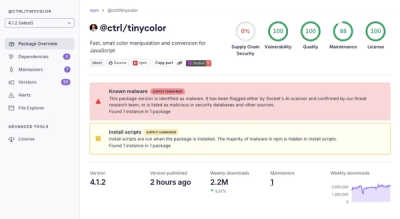What is react-markdown?
The react-markdown npm package is a markdown renderer for React applications. It allows you to take Markdown content and render it as React components. This is useful for content-driven applications, such as blogs or documentation sites, where you want to allow content creators to write in Markdown and then display that content within your React application.
What are react-markdown's main functionalities?
Rendering Markdown
This feature allows you to render standard Markdown text as React components. The example code shows how to import the ReactMarkdown component and use it to render a simple piece of Markdown text.
import React from 'react';
import ReactMarkdown from 'react-markdown';
const markdown = '# Hello, *world*!';
function App() {
return <ReactMarkdown>{markdown}</ReactMarkdown>;
}
export default App;
Custom Renderers
This feature allows you to define custom renderers for different Markdown elements. In the example, a custom renderer is provided for 'h1' elements, which renders them with a blue color.
import React from 'react';
import ReactMarkdown from 'react-markdown';
const markdown = '# Hello, *world*!';
function HeadingRenderer(props) {
return <h1 style={{ color: 'blue' }}>{props.children}</h1>;
}
function App() {
return (
<ReactMarkdown
components={{
h1: HeadingRenderer
}}
>
{markdown}
</ReactMarkdown>
);
}
export default App;
Inline HTML and Skip HTML
This feature allows you to include or exclude inline HTML within your Markdown content. The example code demonstrates how to skip rendering inline HTML by using the 'skipHtml' prop.
import React from 'react';
import ReactMarkdown from 'react-markdown';
const markdown = 'This is a paragraph with <span style="color: red;">inline HTML</span>.';
function App() {
return (
<ReactMarkdown skipHtml>
{markdown}
</ReactMarkdown>
);
}
export default App;
Plugins
This feature allows you to extend the functionality of react-markdown with plugins. The example code shows how to use the 'remark-gfm' plugin to add support for GitHub Flavored Markdown (GFM) task lists.
import React from 'react';
import ReactMarkdown from 'react-markdown';
import gfm from 'remark-gfm';
const markdown = 'This supports GitHub Flavored Markdown (GFM)\n\n- [ ] todo\n- [x] done';
function App() {
return <ReactMarkdown remarkPlugins={[gfm]}>{markdown}</ReactMarkdown>;
}
export default App;
Other packages similar to react-markdown
marked
Marked is a low-level markdown compiler for parsing markdown without caching or blocking for long periods of time. It is less React-specific than react-markdown and requires additional work to integrate with React.
remarkable
Remarkable is a highly configurable markdown parser and compiler. It offers similar functionality to react-markdown but is not designed specifically for React and does not render React components out of the box.
markdown-to-jsx
markdown-to-jsx is another React component that lets you render Markdown as React components. It is similar to react-markdown but offers a simpler API with less configurability, which might be preferable for simpler use cases.
react-markdown







React component to render markdown.
Feature highlights
Contents
What is this?
This package is a React component that can be given a string of markdown
that it’ll safely render to React elements.
You can pass plugins to change how markdown is transformed to React elements and
pass components that will be used instead of normal HTML elements.
When should I use this?
There are other ways to use markdown in React out there so why use this one?
The two main reasons are that they often rely on dangerouslySetInnerHTML or
have bugs with how they handle markdown.
react-markdown uses a syntax tree to build the virtual dom which allows for
updating only the changing DOM instead of completely overwriting.
react-markdown is 100% CommonMark compliant and has plugins to support other
syntax extensions (such as GFM).
These features are supported because we use unified, specifically remark
for markdown and rehype for HTML, which are popular tools to transform
content with plugins.
This package focusses on making it easy for beginners to safely use markdown in
React.
When you’re familiar with unified, you can use a modern hooks based alternative
react-remark or rehype-react manually.
If you instead want to use JavaScript and JSX inside markdown files, use
MDX.
Install
This package is ESM only.
In Node.js (version 12.20+, 14.14+, or 16.0+), install with npm:
npm install react-markdown
In Deno with esm.sh:
import ReactMarkdown from 'https://esm.sh/react-markdown@7'
In browsers with esm.sh:
<script type="module">
import ReactMarkdown from 'https://esm.sh/react-markdown@7?bundle'
</script>
Use
A basic hello world:
import React from 'react'
import ReactMarkdown from 'react-markdown'
import ReactDom from 'react-dom'
ReactDom.render(<ReactMarkdown># Hello, *world*!</ReactMarkdown>, document.body)
Show equivalent JSX
<h1>
Hello, <em>world</em>!
</h1>
Here is an example that shows passing the markdown as a string and how
to use a plugin (remark-gfm, which adds support for strikethrough,
tables, tasklists and URLs directly):
import React from 'react'
import ReactDom from 'react-dom'
import ReactMarkdown from 'react-markdown'
import remarkGfm from 'remark-gfm'
const markdown = `Just a link: https://reactjs.com.`
ReactDom.render(
<ReactMarkdown children={markdown} remarkPlugins={[remarkGfm]} />,
document.body
)
Show equivalent JSX
<p>
Just a link: <a href="https://reactjs.com">https://reactjs.com</a>.
</p>
API
This package exports the following identifier:
uriTransformer.
The default export is ReactMarkdown.
props
children (string, default: '')
markdown to parsecomponents (Record<string, Component>, default: {})
object mapping tag names to React componentsremarkPlugins (Array<Plugin>, default: [])
list of remark plugins to userehypePlugins (Array<Plugin>, default: [])
list of rehype plugins to useremarkRehypeOptions (Object?, default: undefined)
options to pass through to remark-rehypeclassName (string?)
wrap the markdown in a div with this class nameskipHtml (boolean, default: false)
ignore HTML in markdown completelysourcePos (boolean, default: false)
pass a prop to all components with a serialized position
(data-sourcepos="3:1-3:13")rawSourcePos (boolean, default: false)
pass a prop to all components with their position
(sourcePosition: {start: {line: 3, column: 1}, end:…})includeElementIndex (boolean, default: false)
pass the index (number of elements before it) and siblingCount (number
of elements in parent) as props to all componentsallowedElements (Array<string>, default: undefined)
tag names to allow (can’t combine w/ disallowedElements), all tag names
are allowed by defaultdisallowedElements (Array<string>, default: undefined)
tag names to disallow (can’t combine w/ allowedElements), all tag names
are allowed by defaultallowElement ((element, index, parent) => boolean?, optional)
function called to check if an element is allowed (when truthy) or not,
allowedElements or disallowedElements is used first!unwrapDisallowed (boolean, default: false)
extract (unwrap) the children of not allowed elements, by default, when
strong is disallowed, it and it’s children are dropped, but with
unwrapDisallowed the element itself is replaced by its childrenlinkTarget (string or (href, children, title) => string, optional)
target to use on links (such as _blank for <a target="_blank"…)transformLinkUri ((href, children, title) => string, default:
uriTransformer, optional)
change URLs on links, pass null to allow all URLs, see securitytransformImageUri ((src, alt, title) => string, default:
uriTransformer, optional)
change URLs on images, pass null to allow all URLs, see security
uriTransformer
Our default URL transform, which you can overwrite (see props above).
It’s given a URL and cleans it, by allowing only http:, https:, mailto:,
and tel: URLs, absolute paths (/example.png), and hashes (#some-place).
See the source code here.
Examples
Use a plugin
This example shows how to use a remark plugin.
In this case, remark-gfm, which adds support for strikethrough, tables,
tasklists and URLs directly:
import React from 'react'
import ReactMarkdown from 'react-markdown'
import ReactDom from 'react-dom'
import remarkGfm from 'remark-gfm'
const markdown = `A paragraph with *emphasis* and **strong importance**.
> A block quote with ~strikethrough~ and a URL: https://reactjs.org.
* Lists
* [ ] todo
* [x] done
A table:
| a | b |
| - | - |
`
ReactDom.render(
<ReactMarkdown children={markdown} remarkPlugins={[remarkGfm]} />,
document.body
)
Show equivalent JSX
<>
<p>
A paragraph with <em>emphasis</em> and <strong>strong importance</strong>.
</p>
<blockquote>
<p>
A block quote with <del>strikethrough</del> and a URL:{' '}
<a href="https://reactjs.org">https://reactjs.org</a>.
</p>
</blockquote>
<ul>
<li>Lists</li>
<li>
<input checked={false} readOnly={true} type="checkbox" /> todo
</li>
<li>
<input checked={true} readOnly={true} type="checkbox" /> done
</li>
</ul>
<p>A table:</p>
<table>
<thead>
<tr>
<td>a</td>
<td>b</td>
</tr>
</thead>
</table>
</>
Use a plugin with options
This example shows how to use a plugin and give it options.
To do that, use an array with the plugin at the first place, and the options
second.
remark-gfm has an option to allow only double tildes for strikethrough:
import React from 'react'
import ReactMarkdown from 'react-markdown'
import ReactDom from 'react-dom'
import remarkGfm from 'remark-gfm'
ReactDom.render(
<ReactMarkdown remarkPlugins={[[remarkGfm, {singleTilde: false}]]}>
This ~is not~ strikethrough, but ~~this is~~!
</ReactMarkdown>,
document.body
)
Show equivalent JSX
<p>
This ~is not~ strikethrough, but <del>this is</del>!
</p>
Use custom components (syntax highlight)
This example shows how you can overwrite the normal handling of an element by
passing a component.
In this case, we apply syntax highlighting with the seriously super amazing
react-syntax-highlighter by
@conorhastings:
import React from 'react'
import ReactDom from 'react-dom'
import ReactMarkdown from 'react-markdown'
import {Prism as SyntaxHighlighter} from 'react-syntax-highlighter'
import {dark} from 'react-syntax-highlighter/dist/esm/styles/prism'
const markdown = `Here is some JavaScript code:
~~~js
console.log('It works!')
~~~
`
ReactDom.render(
<ReactMarkdown
children={markdown}
components={{
code({node, inline, className, children, ...props}) {
const match = /language-(\w+)/.exec(className || '')
return !inline && match ? (
<SyntaxHighlighter
{...props}
children={String(children).replace(/\n$/, '')}
style={dark}
language={match[1]}
PreTag="div"
/>
) : (
<code {...props} className={className}>
{children}
</code>
)
}
}}
/>,
document.body
)
Show equivalent JSX
<>
<p>Here is some JavaScript code:</p>
<pre>
<SyntaxHighlighter language="js" style={dark} PreTag="div" children="console.log('It works!')" />
</pre>
</>
Use remark and rehype plugins (math)
This example shows how a syntax extension (through remark-math)
is used to support math in markdown, and a transform plugin
(rehype-katex) to render that math.
import React from 'react'
import ReactDom from 'react-dom'
import ReactMarkdown from 'react-markdown'
import remarkMath from 'remark-math'
import rehypeKatex from 'rehype-katex'
import 'katex/dist/katex.min.css'
ReactDom.render(
<ReactMarkdown
children={`The lift coefficient ($C_L$) is a dimensionless coefficient.`}
remarkPlugins={[remarkMath]}
rehypePlugins={[rehypeKatex]}
/>,
document.body
)
Show equivalent JSX
<p>
The lift coefficient (
<span className="math math-inline">
<span className="katex">
<span className="katex-mathml">
<math xmlns="http://www.w3.org/1998/Math/MathML">{/* … */}</math>
</span>
<span className="katex-html" aria-hidden="true">
{/* … */}
</span>
</span>
</span>
) is a dimensionless coefficient.
</p>
Plugins
We use unified, specifically remark for markdown and rehype for
HTML, which are tools to transform content with plugins.
Here are three good ways to find plugins:
Syntax
react-markdown follows CommonMark, which standardizes the differences between
markdown implementations, by default.
Some syntax extensions are supported through plugins.
We use micromark under the hood for our parsing.
See its documentation for more information on markdown, CommonMark, and
extensions.
Types
This package is fully typed with TypeScript.
It exports Options and Components types, which specify the interface of the
accepted props and components.
Compatibility
Projects maintained by the unified collective are compatible with all maintained
versions of Node.js.
As of now, that is Node.js 12.20+, 14.14+, and 16.0+.
Our projects sometimes work with older versions, but this is not guaranteed.
They work in all modern browsers (essentially: everything not IE 11).
You can use a bundler (such as esbuild, webpack, or Rollup) to use this package
in your project, and use its options (or plugins) to add support for legacy
browsers.
Architecture
react-markdown
+----------------------------------------------------------------------------------------------------------------+
| |
| +----------+ +----------------+ +---------------+ +----------------+ +------------+ |
| | | | | | | | | | | |
markdown-+->+ remark +-mdast->+ remark plugins +-mdast->+ remark-rehype +-hast->+ rehype plugins +-hast->+ components +-+->react elements
| | | | | | | | | | | |
| +----------+ +----------------+ +---------------+ +----------------+ +------------+ |
| |
+----------------------------------------------------------------------------------------------------------------+
To understand what this project does, it’s important to first understand what
unified does: please read through the unifiedjs/unified readme (the
part until you hit the API section is required reading).
react-markdown is a unified pipeline — wrapped so that most folks don’t need
to directly interact with unified.
The processor goes through these steps:
- parse markdown to mdast (markdown syntax tree)
- transform through remark (markdown ecosystem)
- transform mdast to hast (HTML syntax tree)
- transform through rehype (HTML ecosystem)
- render hast to React with components
Appendix A: HTML in markdown
react-markdown typically escapes HTML (or ignores it, with skipHtml)
because it is dangerous and defeats the purpose of this library.
However, if you are in a trusted environment (you trust the markdown), and
can spare the bundle size (±60kb minzipped), then you can use
rehype-raw:
import React from 'react'
import ReactDom from 'react-dom'
import ReactMarkdown from 'react-markdown'
import rehypeRaw from 'rehype-raw'
const input = `<div class="note">
Some *emphasis* and <strong>strong</strong>!
</div>`
ReactDom.render(
<ReactMarkdown rehypePlugins={[rehypeRaw]} children={input} />,
document.body
)
Show equivalent JSX
<div class="note">
<p>Some <em>emphasis</em> and <strong>strong</strong>!</p>
</div>
Note: HTML in markdown is still bound by how HTML works in
CommonMark.
Make sure to use blank lines around block-level HTML that again contains
markdown!
Appendix B: Components
You can also change the things that come from markdown:
<ReactMarkdown
components={{
h1: 'h2',
em: ({node, ...props}) => <i style={{color: 'red'}} {...props} />
}}
/>
The keys in components are HTML equivalents for the things you write with
markdown (such as h1 for # heading).
Normally, in markdown, those are: a, blockquote, br, code, em, h1,
h2, h3, h4, h5, h6, hr, img, li, ol, p, pre, strong, and
ul.
With remark-gfm, you can also use: del, input, table, tbody,
td, th, thead, and tr.
Other remark or rehype plugins that add support for new constructs will also
work with react-markdown.
The props that are passed are what you probably would expect: an a (link) will
get href (and title) props, and img (image) an src, alt and title,
etc.
There are some extra props passed.
code
inline (boolean?)
— set to true for inline codeclassName (string?)
— set to language-js or so when using ```js
h1, h2, h3, h4, h5, h6
level (number between 1 and 6)
— heading rank
input (when using remark-gfm)
checked (boolean)
— whether the item is checkeddisabled (true)type ('checkbox')
li
index (number)
— number of preceding items (so first gets 0, etc.)ordered (boolean)
— whether the parent is an ol or notchecked (boolean?)
— null normally, boolean when using remark-gfm’s tasklistsclassName (string?)
— set to task-list-item when using remark-gfm and the
item1 is a tasklist
ol, ul
depth (number)
— number of ancestral lists (so first gets 0, etc.)ordered (boolean)
— whether it’s an ol or notclassName (string?)
— set to contains-task-list when using remark-gfm and the
list contains one or more tasklists
td, th (when using remark-gfm)
style (Object?)
— something like {textAlign: 'left'} depending on how the cell is
alignedisHeader (boolean)
— whether it’s a th or not
tr (when using remark-gfm)
isHeader (boolean)
— whether it’s in the thead or not
Every component will receive a node (Object).
This is the original hast element being
turned into a React element.
Every element will receive a key (string).
See React’s docs for more
info.
Optionally, components will also receive:
data-sourcepos (string)
— see sourcePos optionsourcePosition (Object)
— see rawSourcePos optionindex and siblingCount (number)
— see includeElementIndex optiontarget on a (string)
— see linkTarget option
Security
Use of react-markdown is secure by default.
Overwriting transformLinkUri or transformImageUri to something insecure will
open you up to XSS vectors.
Furthermore, the remarkPlugins, rehypePlugins, and components you use may
be insecure.
To make sure the content is completely safe, even after what plugins do,
use rehype-sanitize.
It lets you define your own schema of what is and isn’t allowed.
Related
Contribute
See contributing.md in remarkjs/.github for ways
to get started.
See support.md for ways to get help.
This project has a code of conduct.
By interacting with this repository, organization, or community you agree to
abide by its terms.
License
MIT © Espen Hovlandsdal







